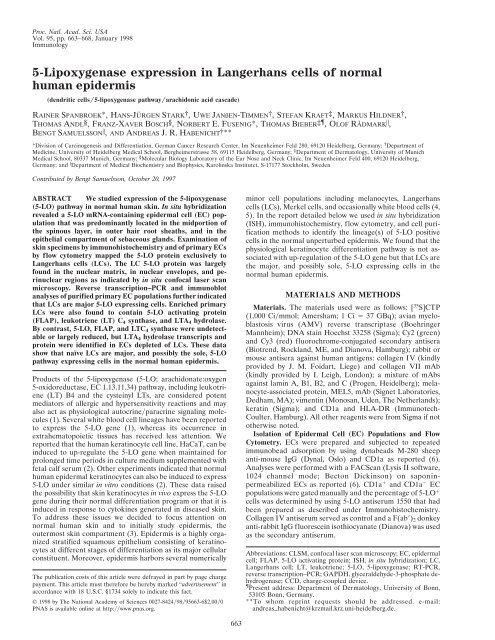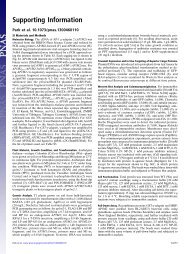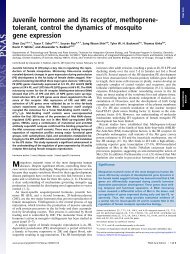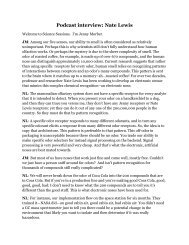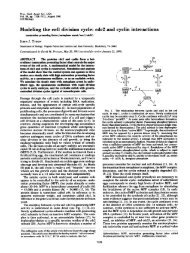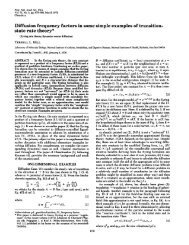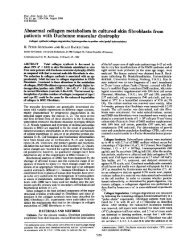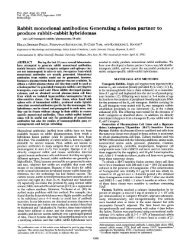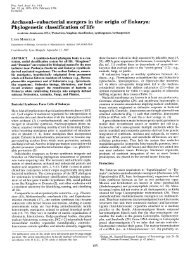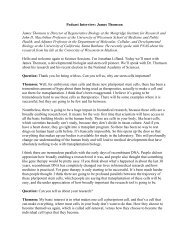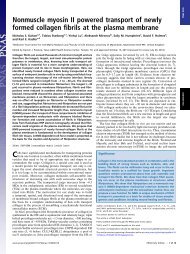5-Lipoxygenase expression in Langerhans cells of normal human ...
5-Lipoxygenase expression in Langerhans cells of normal human ...
5-Lipoxygenase expression in Langerhans cells of normal human ...
Create successful ePaper yourself
Turn your PDF publications into a flip-book with our unique Google optimized e-Paper software.
Proc. Natl. Acad. Sci. USA<br />
Vol. 95, pp. 663–668, January 1998<br />
Immunology<br />
5-<strong>Lipoxygenase</strong> <strong>expression</strong> <strong>in</strong> <strong>Langerhans</strong> <strong>cells</strong> <strong>of</strong> <strong>normal</strong><br />
<strong>human</strong> epidermis<br />
(dendritic <strong>cells</strong>�5-lipoxygenase pathway�arachidonic acid cascade)<br />
RAINER SPANBROEK*, HANS-JÜRGEN STARK†, UWE JANßEN-TIMMEN†, STEFAN KRAFT‡, MARKUS HILDNER†,<br />
THOMAS ANDL§, FRANZ-XAVER BOSCH§, NORBERT E. FUSENIG*, THOMAS BIEBER‡, OLOF RÅDMARK � ,<br />
BENGT SAMUELSSON � , AND ANDREAS J. R. HABENICHT†**<br />
*Division <strong>of</strong> Carc<strong>in</strong>ogenesis and Differentiation, German Cancer Research Center, Im Neuenheimer Feld 280, 69120 Heidelberg, Germany; † Department <strong>of</strong><br />
Medic<strong>in</strong>e, University <strong>of</strong> Heidelberg Medical School, Bergheimerstrasse 58, 69115 Heidelberg, Germany; ‡ Department <strong>of</strong> Dermatology, University <strong>of</strong> Munich<br />
Medical School, 80337 Munich, Germany; § Molecular Biology Laboratory <strong>of</strong> the Ear Nose and Neck Cl<strong>in</strong>ic, Im Neuenheimer Feld 400, 69120 Heidelberg,<br />
Germany; and � Department <strong>of</strong> Medical Biochemistry and Biophysics, Karol<strong>in</strong>ska Institutet, S-17177 Stockholm, Sweden<br />
Contributed by Bengt Samuelsson, October 20, 1997<br />
ABSTRACT We studied <strong>expression</strong> <strong>of</strong> the 5-lipoxygenase<br />
(5-LO) pathway <strong>in</strong> <strong>normal</strong> <strong>human</strong> sk<strong>in</strong>. In situ hybridization<br />
revealed a 5-LO mRNA-conta<strong>in</strong><strong>in</strong>g epidermal cell (EC) population<br />
that was predom<strong>in</strong>antly located <strong>in</strong> the midportion <strong>of</strong><br />
the sp<strong>in</strong>ous layer, <strong>in</strong> outer hair root sheaths, and <strong>in</strong> the<br />
epithelial compartment <strong>of</strong> sebaceous glands. Exam<strong>in</strong>ation <strong>of</strong><br />
sk<strong>in</strong> specimens by immunohistochemistry and <strong>of</strong> primary ECs<br />
by flow cytometry mapped the 5-LO prote<strong>in</strong> exclusively to<br />
<strong>Langerhans</strong> <strong>cells</strong> (LCs). The LC 5-LO prote<strong>in</strong> was largely<br />
found <strong>in</strong> the nuclear matrix, <strong>in</strong> nuclear envelopes, and per<strong>in</strong>uclear<br />
regions as <strong>in</strong>dicated by <strong>in</strong> situ confocal laser scan<br />
microscopy. Reverse transcription–PCR and immunoblot<br />
analyses <strong>of</strong> purified primary EC populations further <strong>in</strong>dicated<br />
that LCs are major 5-LO express<strong>in</strong>g <strong>cells</strong>. Enriched primary<br />
LCs were also found to conta<strong>in</strong> 5-LO activat<strong>in</strong>g prote<strong>in</strong><br />
(FLAP), leukotriene (LT) C4 synthase, and LTA4 hydrolase.<br />
By contrast, 5-LO, FLAP, and LTC4 synthase were undetectable<br />
or largely reduced, but LTA4 hydrolase transcripts and<br />
prote<strong>in</strong> were identified <strong>in</strong> ECs depleted <strong>of</strong> LCs. These data<br />
show that naïve LCs are major, and possibly the sole, 5-LO<br />
pathway express<strong>in</strong>g <strong>cells</strong> <strong>in</strong> the <strong>normal</strong> <strong>human</strong> epidermis.<br />
Products <strong>of</strong> the 5-lipoxygenase (5-LO; arachidonate:oxygen<br />
5-oxidoreductase, EC 1.13.11.34) pathway, <strong>in</strong>clud<strong>in</strong>g leukotriene<br />
(LT) B4 and the cyste<strong>in</strong>yl LTs, are considered potent<br />
mediators <strong>of</strong> allergic and hypersensitivity reactions and may<br />
also act as physiological autocr<strong>in</strong>e�paracr<strong>in</strong>e signal<strong>in</strong>g molecules<br />
(1). Several white blood cell l<strong>in</strong>eages have been reported<br />
to express the 5-LO gene (1), whereas its occurrence <strong>in</strong><br />
extrahematopoietic tissues has received less attention. We<br />
reported that the <strong>human</strong> kerat<strong>in</strong>ocyte cell l<strong>in</strong>e, HaCaT, can be<br />
<strong>in</strong>duced to up-regulate the 5-LO gene when ma<strong>in</strong>ta<strong>in</strong>ed for<br />
prolonged time periods <strong>in</strong> culture medium supplemented with<br />
fetal calf serum (2). Other experiments <strong>in</strong>dicated that <strong>normal</strong><br />
<strong>human</strong> epidermal kerat<strong>in</strong>ocytes can also be <strong>in</strong>duced to express<br />
5-LO under similar <strong>in</strong> vitro conditions (2). These data raised<br />
the possibility that sk<strong>in</strong> kerat<strong>in</strong>ocytes <strong>in</strong> vivo express the 5-LO<br />
gene dur<strong>in</strong>g their <strong>normal</strong> differentiation program or that it is<br />
<strong>in</strong>duced <strong>in</strong> response to cytok<strong>in</strong>es generated <strong>in</strong> diseased sk<strong>in</strong>.<br />
To address these issues we decided to focus attention on<br />
<strong>normal</strong> <strong>human</strong> sk<strong>in</strong> and to <strong>in</strong>itially study epidermis, the<br />
outermost sk<strong>in</strong> compartment (3). Epidermis is a highly organized<br />
stratified squamous epithelium consist<strong>in</strong>g <strong>of</strong> kerat<strong>in</strong>ocytes<br />
at different stages <strong>of</strong> differentiation as its major cellular<br />
constituent. Moreover, epidermis harbors several numerically<br />
The publication costs <strong>of</strong> this article were defrayed <strong>in</strong> part by page charge<br />
payment. This article must therefore be hereby marked ‘‘advertisement’’ <strong>in</strong><br />
accordance with 18 U.S.C. §1734 solely to <strong>in</strong>dicate this fact.<br />
© 1998 by The National Academy <strong>of</strong> Sciences 0027-8424�98�95663-6$2.00�0<br />
PNAS is available onl<strong>in</strong>e at http:��www.pnas.org.<br />
663<br />
m<strong>in</strong>or cell populations <strong>in</strong>clud<strong>in</strong>g melanocytes, <strong>Langerhans</strong><br />
<strong>cells</strong> (LCs), Merkel <strong>cells</strong>, and occasionally white blood <strong>cells</strong> (4,<br />
5). In the report detailed below we used <strong>in</strong> situ hybridization<br />
(ISH), immunohistochemistry, flow cytometry, and cell purification<br />
methods to identify the l<strong>in</strong>eage(s) <strong>of</strong> 5-LO positive<br />
<strong>cells</strong> <strong>in</strong> the <strong>normal</strong> unperturbed epidermis. We found that the<br />
physiological kerat<strong>in</strong>ocyte differentiation pathway is not associated<br />
with up-regulation <strong>of</strong> the 5-LO gene but that LCs are<br />
the major, and possibly sole, 5-LO express<strong>in</strong>g <strong>cells</strong> <strong>in</strong> the<br />
<strong>normal</strong> <strong>human</strong> epidermis.<br />
MATERIALS AND METHODS<br />
Materials. The materials used were as follows: [ 35 S]CTP<br />
(1,000 Ci�mmol; Amersham; 1 Ci � 37 GBq); avian myeloblastosis<br />
virus (AMV) reverse transcriptase (Boehr<strong>in</strong>ger<br />
Mannheim); DNA sta<strong>in</strong> Hoechst 33258 (Sigma); Cy2 (green)<br />
and Cy3 (red) fluorochrome-conjugated secondary antisera<br />
(Biotrend, Rockland, ME, and Dianova, Hamburg); rabbit or<br />
mouse antisera aga<strong>in</strong>st <strong>human</strong> antigens: collagen IV (k<strong>in</strong>dly<br />
provided by J. M. Foidart, Liege) and collagen VII mAb<br />
(k<strong>in</strong>dly provided by I. Leigh, London); a mixture <strong>of</strong> mAbs<br />
aga<strong>in</strong>st lam<strong>in</strong> A, B1, B2, and C (Progen, Heidelberg); melanocyte-associated<br />
prote<strong>in</strong>, MEL5, mAb (Signet Laboratories,<br />
Dedham, MA); viment<strong>in</strong> (Monosan, Uden, The Netherlands);<br />
kerat<strong>in</strong> (Sigma); and CD1a and HLA-DR (Immunotech-<br />
Coulter, Hamburg). All other reagents were from Sigma if not<br />
otherwise noted.<br />
Isolation <strong>of</strong> Epidermal Cell (EC) Populations and Flow<br />
Cytometry. ECs were prepared and subjected to repeated<br />
immunobead adsorption by us<strong>in</strong>g dynabeads M-280 sheep<br />
anti-mouse IgG (Dynal, Oslo) and CD1a as reported (6).<br />
Analyses were performed with a FACScan (Lysis II s<strong>of</strong>tware,<br />
1024 channel mode; Becton Dick<strong>in</strong>son) on sapon<strong>in</strong>permeabilized<br />
ECs as reported (6). CD1a � and CD1a � EC<br />
populations were gated manually and the percentage <strong>of</strong> 5-LO �<br />
<strong>cells</strong> was determ<strong>in</strong>ed by us<strong>in</strong>g 5-LO antiserum 1550 that had<br />
been prepared as described under Immunohistochemistry.<br />
Collagen IV antiserum served as control and a F(ab�)2 donkey<br />
anti-rabbit IgG fluoresce<strong>in</strong> isothiocyanate (Dianova) was used<br />
as the secondary antiserum.<br />
Abbreviations: CLSM, confocal laser scan microscopy; EC, epidermal<br />
cell; FLAP, 5-LO activat<strong>in</strong>g prote<strong>in</strong>; ISH, <strong>in</strong> situ hybridization; LC,<br />
<strong>Langerhans</strong> cell; LT, leukotriene; 5-LO, 5-lipoxygenase; RT-PCR,<br />
reverse transcription–PCR; GAPDH, glyceraldehyde-3-phosphate dehydrogenase;<br />
CCD, charge-coupled device.<br />
Present address: Department <strong>of</strong> Dermatology, University <strong>of</strong> Bonn,<br />
53105 Bonn, Germany.<br />
**To whom repr<strong>in</strong>t requests should be addressed. e-mail:<br />
andreas _ habenicht@krzmail.krz.uni-heidelberg.de.
664 Immunology: Spanbroek et al. Proc. Natl. Acad. Sci. USA 95 (1998)<br />
ISH and Reverse Transcription–PCR (RT-PCR). Human<br />
5-LO cDNA (nucleotides 1–2496) was subcloned <strong>in</strong>to pBluescript<br />
II KS vector (Stratagene) and 35 S-labeled cRNA antisense<br />
and sense fragment lengths were adjusted to 250 nucleotides<br />
by us<strong>in</strong>g standard techniques as reported (7–9). RT-<br />
PCR analyses were performed as described (2). Details <strong>of</strong><br />
tissue preparation, hybridization conditions, probe specificities,<br />
primer sequences, PCR parameters, and competitive PCR<br />
are available on request.<br />
Immunohistochemistry and Confocal Laser Scan Microscopy<br />
(CLSM). Three polyclonal rabbit anti 5-LO antisera, LO<br />
32, 1550 (directed aga<strong>in</strong>st native purified recomb<strong>in</strong>ant <strong>human</strong><br />
5-LO), and 1551 (directed aga<strong>in</strong>st SDS-denatured purified<br />
recomb<strong>in</strong>ant <strong>human</strong> 5-LO), were used with similar results. The<br />
1550 and 1551 antisera were aff<strong>in</strong>ity-purified on recomb<strong>in</strong>ant<br />
5-LO bound to nitrocellulose paper by us<strong>in</strong>g established<br />
techniques. To reduce unspecific b<strong>in</strong>d<strong>in</strong>g, all antisera were<br />
preadsorbed on cytoskeletal prote<strong>in</strong>s prepared from <strong>human</strong><br />
epidermis as described (10). Sk<strong>in</strong> specimens were embedded <strong>in</strong><br />
Tissue TeK (Miles) and snap frozen <strong>in</strong> liquid nitrogen. Cryosections<br />
(4–7 �m) were transferred onto slides and air dried.<br />
For optimal results 5-LO antisera required 12- to 18-h <strong>in</strong>cubations.<br />
Aff<strong>in</strong>ity-purified fluorochrome-conjugated secondary<br />
antisera were donkey anti-mouse IgG F(ab�)2 (Dianova), goat<br />
anti-mouse IgG, goat or donkey anti-rabbit IgG F(ab�)2, or<br />
<strong>in</strong>tact IgG (Biotrend). For the generation <strong>of</strong> electronical<br />
microscopical images (Fig. 2I) a Zeiss Axiophot I microscope<br />
equipped with a charge-coupled device (CCD) camera (Photometrics,<br />
Tuscon, AZ) was used. CLSM was performed on<br />
paraformaldehyde-fixed sk<strong>in</strong> cryosections by us<strong>in</strong>g a Leica DM<br />
IRBE microscope (Leica) equipped with a scanner head Leica<br />
TCS NT and argon-crypton laser. 5-LO prote<strong>in</strong> was visualized<br />
with LO32 antiserum (or 1550, data not shown), DNA with<br />
propidium iodide, and nuclear envelopes with lam<strong>in</strong> antisera<br />
as described under Materials. Details <strong>of</strong> fixation, sta<strong>in</strong><strong>in</strong>g,<br />
antibody dilutions, s<strong>of</strong>tware, and record<strong>in</strong>g are available on<br />
request.<br />
Immunoblot. Analyses were performed by us<strong>in</strong>g polyclonal<br />
rabbit antisera aga<strong>in</strong>st 5-LO, 5-LO activat<strong>in</strong>g prote<strong>in</strong> (FLAP),<br />
and LTA4 hydrolase as described (2) and under Immunohistochemistry.<br />
Triton X-100 (1%) soluble extracts (35 �g prote<strong>in</strong>)<br />
or leukocyte membranes (5 �g prote<strong>in</strong>) were separated<br />
by 7.5% (5-LO, LTA4 hydrolase) or 15% (FLAP) SDS�PAGE,<br />
transferred to Hybond-C Super membranes, followed by enhanced<br />
chemilum<strong>in</strong>escence (Amersham, Braunschweig). Di-<br />
lutions <strong>of</strong> antisera were as follows: 5-LO, 1:2,000; FLAP, 1:500;<br />
and LTA4 hydrolase, 1:2,000.<br />
RESULTS<br />
mRNA Expression <strong>of</strong> 5-LO Pathway Constituents <strong>in</strong> Normal<br />
Epidermis. Epidermis and dermis from <strong>normal</strong> <strong>human</strong> sk<strong>in</strong><br />
specimens (obta<strong>in</strong>ed from different body sites <strong>of</strong> both sexes<br />
and ages rang<strong>in</strong>g from 30 to 76 years) were separated and<br />
studied by RT-PCR for the presence <strong>of</strong> transcripts <strong>of</strong> 5-LO,<br />
FLAP, LTA4 hydrolase, and LTC4 synthase. PCR products <strong>of</strong><br />
all four 5-LO pathway constituents were found <strong>in</strong> both sk<strong>in</strong><br />
compartments. The amounts <strong>of</strong> 5-LO transcripts <strong>in</strong> total<br />
epidermis RNA, as determ<strong>in</strong>ed by competitive RT-PCR, were<br />
significantly lower than those previously obta<strong>in</strong>ed <strong>in</strong> RNA<br />
from cultured differentiated HaCaT kerat<strong>in</strong>ocytes or buffy<br />
coat RNA (ref. 2; see below).<br />
To identify <strong>in</strong>dividual 5-LO mRNA positive ECs, ISH<br />
analyses were performed. Most ECs, particularly the majority<br />
<strong>of</strong> kerat<strong>in</strong>ocytes <strong>in</strong>clud<strong>in</strong>g the differentiated kerat<strong>in</strong>ocytes <strong>of</strong><br />
the granular layer, did not yield specific hybridization signals<br />
(Fig. 1 A–C). However, <strong>cells</strong> located predom<strong>in</strong>antly <strong>in</strong> the<br />
midportion <strong>of</strong> the sp<strong>in</strong>ous layer and, to a lesser extent, <strong>in</strong> the<br />
basal layer, as well as few <strong>cells</strong> <strong>in</strong> the dermis were strongly<br />
positive (Fig. 1 A–C; additional data not shown). 5-LO mRNA<br />
positive <strong>cells</strong> accounted for only 1–2% <strong>of</strong> the total EC population<br />
and were uniformly located <strong>in</strong> all specimens exam<strong>in</strong>ed.<br />
When epidermal appendages were <strong>in</strong>spected, a substantial<br />
number <strong>of</strong> 5-LO ISH positive <strong>cells</strong> were noted <strong>in</strong> the hair outer<br />
root sheaths (Fig. 1 D–F) and <strong>in</strong> the cellular compartment <strong>of</strong><br />
sebaceous glands (data not shown). These f<strong>in</strong>d<strong>in</strong>gs suggested<br />
that dist<strong>in</strong>ct suprabasal ECs with<strong>in</strong> the midportion <strong>of</strong> the<br />
sp<strong>in</strong>ous layer, a substantial number <strong>of</strong> hair outer root sheath<br />
<strong>cells</strong>, and <strong>cells</strong> <strong>in</strong> sebaceous glands express significant amounts<br />
<strong>of</strong> 5-LO transcripts.<br />
Indirect Immun<strong>of</strong>luorescence <strong>of</strong> Normal Human Sk<strong>in</strong>. Initial<br />
attempts to identify 5-LO prote<strong>in</strong>-express<strong>in</strong>g ECs <strong>in</strong> situ by<br />
us<strong>in</strong>g several polyclonal rabbit 5-LO antisera and control<br />
antisera yielded divergent sta<strong>in</strong><strong>in</strong>g patterns <strong>in</strong> the epidermis<br />
but not <strong>in</strong> the dermis (data not shown). Thus, rabbit 5-LO<br />
antisera and several unrelated rabbit antisera bound to granular<br />
or basal layer kerat<strong>in</strong>ocytes or produced diffuse patterns<br />
<strong>of</strong> cytoplasmic epidermal fluorescence. Similar phenomena<br />
have been found by others to be caused by unspecific b<strong>in</strong>d<strong>in</strong>g<br />
<strong>of</strong> rabbit preimmune or immune antisera to cytoskeletal and<br />
FIG. 1. ISH <strong>of</strong> 5-LO mRNA <strong>in</strong> <strong>human</strong> sk<strong>in</strong>. (A) Epidermis: 5-LO antisense bright field. (B) Epidermis 5-LO antisense. (C) Epidermis 5-LO<br />
sense. (D) Hair root antisense bright field. (E) Hair root antisense. (F) Hair root 5-LO sense. (Bar � 45 �m.)
Immunology: Spanbroek et al. Proc. Natl. Acad. Sci. USA 95 (1998) 665<br />
other prote<strong>in</strong>s (11–13). To avoid unspecific b<strong>in</strong>d<strong>in</strong>g both 5-LO<br />
and control antisera were preadsorbed on Triton X-100 <strong>in</strong>soluble<br />
extracts <strong>of</strong> <strong>normal</strong> <strong>human</strong> epidermis (10). In addition, two<br />
polyclonal rabbit anti 5-LO antisera, 1550 and 1551, were<br />
aff<strong>in</strong>ity purified. Apparent unspecific b<strong>in</strong>d<strong>in</strong>g was largely<br />
elim<strong>in</strong>ated <strong>in</strong> immunohistochemistry and reexam<strong>in</strong>ation <strong>of</strong><br />
<strong>human</strong> sk<strong>in</strong> specimens by us<strong>in</strong>g preadsorbed 5-LO antisera<br />
revealed that most ECs did not yield positive fluorescence<br />
signals <strong>in</strong> any kerat<strong>in</strong>ocyte layer (Fig. 2A). However, analogous<br />
to the distribution pattern <strong>of</strong> positive 5-LO ISH signals (Fig. 1),<br />
ECs located predom<strong>in</strong>antly and regularly <strong>in</strong> the midportion <strong>of</strong><br />
the sp<strong>in</strong>ous layer, dist<strong>in</strong>ct hair outer root sheath <strong>cells</strong>, and<br />
scattered dermal <strong>cells</strong> showed positive fluorescence signals<br />
(Fig. 2A; additional data not shown). When control rabbit IgG<br />
was used or primary antisera were omitted, no fluorescence<br />
signals were recorded (data not shown). Pre<strong>in</strong>cubation <strong>of</strong> 5-LO<br />
antisera with recomb<strong>in</strong>ant 5-LO prote<strong>in</strong> at 2 �g�100 �l largely<br />
abolished fluorescence positivity <strong>in</strong> immunohistochemistry<br />
and abolished a 78-kDa band <strong>in</strong> epidermis immunoblots<br />
performed on Triton X-100 soluble prote<strong>in</strong>, <strong>in</strong>dicat<strong>in</strong>g that<br />
b<strong>in</strong>d<strong>in</strong>g was specific for 5-LO or 5-LO-related epitopes <strong>in</strong> situ<br />
(Fig. 2B; additional data not shown).<br />
The scattered and regular distribution pattern <strong>of</strong> putative<br />
5-LO positive <strong>cells</strong> <strong>in</strong> the sp<strong>in</strong>ous layer was suggestive <strong>of</strong> LCs<br />
FIG. 2. Immun<strong>of</strong>luorescence histochemistry localizes 5-LO prote<strong>in</strong><br />
<strong>in</strong> naïve LCs <strong>of</strong> <strong>normal</strong> epidermis. Sample designation: female<br />
upper arm, 79 years (C, D, and G–J); male back, 68 years (E); female<br />
breast, 29 years (F); female breast, 23 years (A and B). Upper dotted<br />
l<strong>in</strong>es (A–E, G, and H) del<strong>in</strong>eate the outer border <strong>of</strong> stratum corneum.<br />
Lower dotted l<strong>in</strong>es (C and D) del<strong>in</strong>eate the border between dermis and<br />
epidermis. (A) 5-LO (LO 32 Cy3, red) and collagen VII (Cy2, green).<br />
(B) Same as A but antiserum preadsorbed with recomb<strong>in</strong>ant 5-LO as<br />
described. (C) CD1a Cy2. (D) Same as C plus 5-LO 32, Cy3. (E) 5-LO<br />
1550, Cy3 plus melan<strong>in</strong>-associated prote<strong>in</strong>, MEL5, Cy2. (F) Viment<strong>in</strong>,<br />
Texas red plus kerat<strong>in</strong>, fluoresce<strong>in</strong> isothiocyanate green. (G) 5-LO,<br />
1550, Cy3 plus Hoechst 33258, blue. (H) 5-LO LO 32, Cy3 plus CD1a,<br />
Cy2 plus Hoechst 33258 blue. (I) Same as H but CCD camera-recorded<br />
as described. (J) 5-LO LO 32, Cy3 plus HLA DR, Cy2. (Bars � 50 �m.)<br />
that can be readily identified by their dendritic morphology<br />
and CD1a positivity <strong>in</strong> <strong>normal</strong> <strong>human</strong> epidermis (4, 5). Double<br />
immun<strong>of</strong>luorescence microscopy (Cy2 green fluorochrome<br />
for CD1a antigen; Cy3 red fluorochrome for 5-LO antigen;<br />
colocalization yields yellow) suggested localization <strong>of</strong> 5-LO<br />
and CD1a antigens <strong>in</strong> <strong>in</strong>dividual suprabasal <strong>cells</strong> with a<br />
dendritic morphology (Fig. 2 C and D). By contrast, a melanocyte-specific<br />
antibody, MEL5, largely separated 5-LO � <strong>cells</strong><br />
from melanocytes (Fig. 2E). That the majority <strong>of</strong> presumptive<br />
5-LO � sk<strong>in</strong> <strong>cells</strong> are located <strong>in</strong> the epidermis can be appreciated<br />
<strong>in</strong> specimens treated with both viment<strong>in</strong> antiserum<br />
(sta<strong>in</strong>s melanocytes and LCs <strong>in</strong> the epidermis and endothelial<br />
<strong>cells</strong>, fibroblasts, and hematopoietic <strong>cells</strong> <strong>in</strong> the dermis) and<br />
kerat<strong>in</strong> antiserum (sta<strong>in</strong>s all epidermal kerat<strong>in</strong>ocytes) (Fig.<br />
2F). However, it is noteworthy that 5-LO positive and CD1a�<br />
5-LO double positive <strong>cells</strong> were also found <strong>in</strong> the dermis<br />
<strong>in</strong>dicat<strong>in</strong>g that 5-LO <strong>expression</strong> <strong>in</strong> dendritic <strong>cells</strong> is not restricted<br />
to epidermal LCs (lower part <strong>of</strong> Fig. 2E; additional<br />
data not shown). 5-LO positivity appeared to largely reside <strong>in</strong><br />
the nucleus <strong>in</strong> double sta<strong>in</strong>s <strong>of</strong> 5-LO antisera and DNA b<strong>in</strong>d<strong>in</strong>g<br />
dye Hoechst 33258 (Fig. 2G), and <strong>in</strong> triple sta<strong>in</strong>s <strong>of</strong> 5-LO,<br />
CD1a, and Hoechst 33258 (Fig. 2 H and I). Although we have<br />
<strong>in</strong>spected many 5-LO � <strong>cells</strong> <strong>in</strong> �200 sections, strong cytoplasmic<br />
positivity was never observed <strong>in</strong> conventional immunohistochemistry<br />
(see below under CLSM). Although all 5-LO �<br />
nuclei were associated with peripheral CD1a positivity (Fig.<br />
2D), not all CD1a � structures were associated with 5-LO �<br />
nuclei (Fig. 2 D, H, and I). Because most <strong>of</strong> LCs’ CD1a<br />
occupies the cell surface (4), some LCs’ dendrites were visualized<br />
with no associated localizable 5-LO � nucleus (Fig. 2 D,<br />
H, and I). Thus, though these data are compatible with the<br />
possibility that all LCs are 5-LO � , we cannot firmly establish<br />
this notion due to the limitations <strong>of</strong> histochemistry <strong>in</strong> th<strong>in</strong><br />
tissue sections (see Flow Cytometry below). For better localization<br />
<strong>of</strong> separate signals with<strong>in</strong> s<strong>in</strong>gle <strong>cells</strong> triple fluorescence<br />
signals were recorded with a CCD camera. Colocalization<br />
<strong>of</strong> nuclear 5-LO, cell surface CD1a, and nuclear Hoechst<br />
33258 was apparent <strong>in</strong> <strong>in</strong>dividual epidermal dendritic <strong>cells</strong>,<br />
whereas presumptive surround<strong>in</strong>g kerat<strong>in</strong>ocytes sta<strong>in</strong>ed exclusively<br />
for Hoechst 33258 (Fig. 2I). HLA-DR antisera, which<br />
have been used previously to localize LCs <strong>in</strong> the sk<strong>in</strong> (4), also<br />
localized to 5-LO � <strong>cells</strong> (Fig. 2 J).<br />
When taken together, these data suggested that the majority<br />
<strong>of</strong> 5-LO prote<strong>in</strong>-conta<strong>in</strong><strong>in</strong>g ECs are LCs, and that the 5-LO<br />
prote<strong>in</strong> is located <strong>in</strong> or close to the nucleus.<br />
Flow Cytometry Analyses <strong>of</strong> EC Suspensions. Two color<br />
flow cytometric analyses were performed on two freshly<br />
prepared EC suspensions from <strong>in</strong>dependent <strong>normal</strong> donors.<br />
As shown by histogram analysis, no 5-LO � ECs were detected<br />
<strong>in</strong> the CD1a � population (a total <strong>of</strong> 49,309 <strong>cells</strong> was analyzed<br />
<strong>in</strong> the experiment shown <strong>in</strong> Fig. 3). Thus an unrelated rabbit<br />
IgG (aga<strong>in</strong>st collagen IV) yielded fluorescence <strong>in</strong>tensity that<br />
was as low as that obta<strong>in</strong>ed with the anti 5-LO antiserum (Fig.<br />
FIG. 3. Flow cytometry maps 5-LO prote<strong>in</strong> to CD1a � ECs. ECs<br />
were prepared and flow cytometry analyses performed as described<br />
under Methods. (A) CD1a � <strong>cells</strong>: collagen IV (open), 5-LO 1550<br />
(filled); (B) CD1a � <strong>cells</strong>: collagen IV (open), 5-LO 1550 (filled).
666 Immunology: Spanbroek et al. Proc. Natl. Acad. Sci. USA 95 (1998)<br />
3A). Also, the collagen antiserum yielded a low signal <strong>in</strong> the<br />
CD1a � EC population (Fig. 3B, open histogram). By contrast,<br />
5-LO fluorescence <strong>in</strong>tensity <strong>in</strong> CD1a � ECs (a total <strong>of</strong> 532<br />
CD1a � <strong>cells</strong> was analyzed <strong>in</strong> the experiment shown) was high<br />
(Fig. 3B, closed histograms). This result gives a ratio <strong>of</strong><br />
approximately 59 for 5-LO versus collagen signals <strong>in</strong> the<br />
CD1a � ECs. These data provided evidence aga<strong>in</strong>st the presence<br />
<strong>of</strong> 5-LO � <strong>cells</strong> <strong>in</strong> the CD1a � EC population and <strong>in</strong>dicated<br />
that the majority <strong>of</strong> 5-LO positivity <strong>in</strong> freshly prepared EC<br />
suspensions resides <strong>in</strong> the CD1a � EC subpopulation.<br />
CLSM Localizes 5-LO Prote<strong>in</strong> <strong>in</strong> Dist<strong>in</strong>ct Pools <strong>of</strong> Naïve<br />
LCs. To localize 5-LO prote<strong>in</strong> with<strong>in</strong> CD1a � <strong>cells</strong> <strong>in</strong> situ,<br />
CLSM was applied. Analyses <strong>of</strong> 20 <strong>cells</strong> <strong>in</strong> several <strong>in</strong>dependent<br />
specimens <strong>in</strong>dicated that fluorescence <strong>in</strong>tensity was strongest<br />
<strong>in</strong> nuclear envelopes (Fig. 4 B–D, G, and H) and adjacent<br />
cytoplasmic areas (Fig. 4 B and C), significant with<strong>in</strong> the<br />
nucleus (Fig. 4 E–H), and notably weaker and variable <strong>in</strong> the<br />
dendrites (Fig. 4 G and H). Identical results were obta<strong>in</strong>ed with<br />
two <strong>in</strong>dependent anti-5-LO antisera, LO 32 and 1550. Why not<br />
all dendrites sta<strong>in</strong>ed 5-LO � is unclear but may be caused by<br />
detectability problems because dendrite-associated positivity<br />
was found to be relatively low when compared with that <strong>in</strong> the<br />
nucleus or to areas adjacent to the nucleus. Double sta<strong>in</strong><strong>in</strong>g<br />
with 5-LO antiserum and lam<strong>in</strong> antisera (to del<strong>in</strong>eate the<br />
nuclear envelope) revealed that 5-LO fluorescence colocalized<br />
with lam<strong>in</strong> positivity (Fig. 4 B–D). However, it appeared to<br />
extend beyond lam<strong>in</strong> positivity <strong>in</strong> areas adjacent to both the<br />
<strong>in</strong>ner and the outer nuclear envelopes (Fig. 4 B–D). Double<br />
sta<strong>in</strong><strong>in</strong>g <strong>of</strong> 5-LO with propidium iodide to visualize DNA<br />
showed that 5-LO positivity also colocalized with DNA (compare<br />
Fig. 4 A and E). Aga<strong>in</strong>, areas that extend beyond DNA<br />
were found positive (Fig. 4H). These data <strong>in</strong>dicated that 5-LO<br />
prote<strong>in</strong> is present <strong>in</strong> dist<strong>in</strong>ct cellular pools: (i) <strong>in</strong> nuclear<br />
envelopes (Fig. 4 B–D, G, and H) and with<strong>in</strong> the nucleus (Fig.<br />
4 A, E, and F); (ii) <strong>in</strong> areas adjacent to the cytoplasmic face <strong>of</strong><br />
the outer nuclear envelope (Fig. 4 B–D, G, and H); and (iii) <strong>in</strong><br />
the dendrites (Fig. 4 G and H). These f<strong>in</strong>d<strong>in</strong>gs suggested that<br />
the distribution <strong>of</strong> 5-LO prote<strong>in</strong> <strong>of</strong> naïve epidermal LCs differs<br />
from that <strong>of</strong> rest<strong>in</strong>g <strong>human</strong> blood leukocytes and that it<br />
resembled that <strong>of</strong> Ca 2� ionophore-stimulated <strong>human</strong> blood<br />
leukocytes (14). Immunoelectron microscopy will be required<br />
to more precisely localize 5-LO prote<strong>in</strong> to specific sites with<strong>in</strong><br />
these pools.<br />
Analyses <strong>of</strong> Purified EC Populations. To obta<strong>in</strong> further<br />
evidence for the hypothesis that LCs express 5-LO mRNA and<br />
prote<strong>in</strong>, LCs were purified. For this purpose we prepared<br />
s<strong>in</strong>gle cell suspensions <strong>of</strong> total ECs, and CD1a immunobead<br />
adsorption was used to obta<strong>in</strong> highly purified LC populations<br />
(�90%) and ECs that were depleted <strong>of</strong> LCs (ECs � LCs) (6).<br />
RNA was prepared from these preparations (and from <strong>human</strong><br />
buffy coat as control) and subjected to RT-PCR analyses for<br />
FIG. 4. CLSM reveals dist<strong>in</strong>ct <strong>in</strong>tracellular pools <strong>of</strong> 5-LO prote<strong>in</strong><br />
<strong>in</strong> naïve LCs. Epidermis was fixed and prepared as described under<br />
Methods. (A–D) Colocalization <strong>of</strong> lam<strong>in</strong> (Cy3) and 5-LO, LO32,<br />
antisera (Cy2). (E–H) Colocalization <strong>of</strong> DNA b<strong>in</strong>d<strong>in</strong>g dye propidium<br />
iodide (red) and 5-LO, LO 32 Cy2. (A–D) Eight planes with distances<br />
<strong>of</strong> 0.9 �m each were recorded; planes 2, 4, 6, and 8 are shown. (E–H)<br />
Eleven planes with distances <strong>of</strong> 1 �m each were recorded; planes 2, 5,<br />
8, and 11 are shown. (Bars � 2 �m.)<br />
transcripts <strong>of</strong> all 5-LO pathway constituents, a panel <strong>of</strong> EC and<br />
hematopoietic cell markers, and two housekeep<strong>in</strong>g genes,<br />
glyceraldehyde-3-phosphate dehydrogenase (GAPDH) and<br />
�-act<strong>in</strong>. RT-PCR analyses for CD1a confirmed the enrichment<br />
<strong>of</strong> <strong>cells</strong> express<strong>in</strong>g CD1a <strong>in</strong> the purified LC fractions from two<br />
donors (Table 1). The EC � LC fraction was largely depleted<br />
<strong>of</strong> LCs. Further RT-PCR analyses for marker enzymes showed<br />
that the purified LCs were practically devoid <strong>of</strong> mast <strong>cells</strong><br />
(tryptase) and natural killer <strong>cells</strong>, neutrophils, and macrophages<br />
(CD16). Furthermore, kerat<strong>in</strong> 10 PCR products were<br />
abundant <strong>in</strong> the EC � LC preparation but scarce <strong>in</strong> the<br />
enriched LC preparation. Small amounts <strong>of</strong> tryptase transcripts,<br />
FLAP, and CD1a transcripts <strong>in</strong> EC � LC preparations<br />
could reflect a m<strong>in</strong>or mast cell and LC contam<strong>in</strong>ation (Table<br />
1).<br />
RT-PCR analyses <strong>of</strong> LCs revealed significant amounts <strong>of</strong><br />
5-LO transcripts. The relative amount <strong>of</strong> 5-LO PCR product<br />
<strong>in</strong> LCs exceeded that <strong>in</strong> ECs � LCs by at least two orders <strong>of</strong><br />
magnitude, as judged by competitive RT-PCR by us<strong>in</strong>g external<br />
standard 5-LO and GAPDH cDNAs. Additional calculations<br />
yielded a 5.9-fold abundance <strong>of</strong> GAPDH relative to 5-LO<br />
transcripts <strong>in</strong> purified LCs. Also, the level <strong>of</strong> 5-LO transcripts<br />
<strong>in</strong> purified LCs was found to be similar or higher than found<br />
for 55-day differentiated HaCaT kerat<strong>in</strong>ocytes (ref. 2; additional<br />
data not shown). These data were consistent with the<br />
ISH and immunohistochemical analyses and supported the<br />
conclusion that practically all 5-LO transcripts <strong>in</strong> <strong>normal</strong><br />
<strong>human</strong> epidermis reside <strong>in</strong> LCs and that LCs conta<strong>in</strong> high<br />
levels <strong>of</strong> 5-LO transcripts (2).<br />
Although the sensitivity <strong>of</strong> our FLAP ISH analyses (probably<br />
caused by a shorter cRNA probe when compared with that<br />
<strong>of</strong> 5-LO) was <strong>in</strong>sufficient to detect FLAP ISH signals <strong>in</strong> <strong>normal</strong><br />
epidermis <strong>in</strong> situ, RT-PCR analyses <strong>in</strong>dicated the presence <strong>of</strong><br />
FLAP transcripts <strong>in</strong> LCs (Table 1). Indeed, LCs conta<strong>in</strong>ed<br />
similar or higher amounts <strong>of</strong> FLAP transcripts when compared<br />
with 5-LO transcripts as judged by competitive RT-PCR<br />
analyses (data not shown). Only small amounts <strong>of</strong> FLAP<br />
transcripts were found <strong>in</strong> ECs � LCs. In contrast, high levels<br />
<strong>of</strong> LTA4 hydrolase transcripts were found <strong>in</strong> both LCs and <strong>in</strong><br />
ECs � LCs (Table 1; see also immunoblots <strong>in</strong> Fig. 5). Results<br />
from RT-PCR analyses also showed that LCs conta<strong>in</strong>ed LTC4<br />
synthase (15) transcripts. However, further work should determ<strong>in</strong>e<br />
the EC l<strong>in</strong>eage that expresses LTC4 synthase transcripts,<br />
quantify their abundance and determ<strong>in</strong>e whether the<br />
enzyme is expressed at the prote<strong>in</strong> and enzyme activity levels.<br />
When taken together, our data suggested significant 5-LO,<br />
FLAP, and LTA4 hydrolase transcript levels <strong>in</strong> LCs and<br />
<strong>in</strong>dicated that LTA4 hydrolase transcripts are present also <strong>in</strong><br />
ECs other than LCs.<br />
Immunoblot Analyses <strong>of</strong> ECs and Purified LCs. Total<br />
cellular Triton X-100 soluble extracts were used because it was<br />
Table 1. RT-PCR analyses <strong>of</strong> LCs, ECs � LCs, and <strong>human</strong><br />
leukocyte buffy coat<br />
PCR product LCs ECs � LCs<br />
Buffy<br />
coat<br />
5-LO ��� � ���<br />
FLAP ��� � ���<br />
LTA4 hydrolase ��� ��� ���<br />
LTC4 synthase �� � �<br />
CD1a ��� � ��<br />
Tryptase � � ��<br />
CD16 � � ���<br />
Kerat<strong>in</strong> 10 � ��� �<br />
For preparation <strong>of</strong> ECs and RNA, and RT-PCR, see Materials and<br />
Methods. ���, Detectable at 28 cycles; ��, detectable at 34 cycles;<br />
�, detectable at 40 cycles; �, not detectable at 40 cycles. Markers:<br />
CD1a, LCs; tryptase, mast <strong>cells</strong>; CD16, natural killer <strong>cells</strong>, neutrophils,<br />
and macrophages; kerat<strong>in</strong> 10, kerat<strong>in</strong>ocytes.
Immunology: Spanbroek et al. Proc. Natl. Acad. Sci. USA 95 (1998) 667<br />
FIG. 5. Immunoblots <strong>of</strong> 5-LO, FLAP, and LTA4 hydrolase prote<strong>in</strong>s<br />
<strong>in</strong> ECs, LCs, and EC � LCs. (A) 5-LO. Lanes: 1, ECs; 2, LCs; 3, ECs �<br />
LCs; 4, differentiated HaCaT kerat<strong>in</strong>ocytes; 5, RBL1 <strong>cells</strong>. (B) FLAP.<br />
Lanes: 1, ECs; 2, LCs; 3, ECs � LCs; 4, leukocyte membrane; 5, RBL1<br />
<strong>cells</strong>. (C) LTA4 hydrolase. Lanes: 1, ECs; 2, LCs; 3, ECs � LCs; 4,<br />
differentiated HaCaT kerat<strong>in</strong>ocytes; 5, RBL1 <strong>cells</strong>.<br />
found that these gave better results <strong>in</strong> SDS�PAGE followed by<br />
immunoblot for 5-LO and FLAP when compared with samples<br />
obta<strong>in</strong>ed by solubiliz<strong>in</strong>g the entire <strong>cells</strong> <strong>in</strong> SDS sample load<strong>in</strong>g<br />
buffer. It was ascerta<strong>in</strong>ed <strong>in</strong> <strong>in</strong>dependent experiments performed<br />
with HaCaT kerat<strong>in</strong>ocytes and RBL1 <strong>cells</strong> that Triton<br />
X-100 largely solubilized 5-LO and FLAP. 5-LO immunoblot<br />
analyses showed that 5-LO prote<strong>in</strong> was detectable <strong>in</strong> Triton<br />
X-100 extracts <strong>of</strong> total EC suspensions (Fig. 5). However,<br />
purified LCs conta<strong>in</strong>ed considerably higher amounts <strong>of</strong> 5-LO<br />
prote<strong>in</strong> when compared with EC suspensions. Moreover,<br />
analogous to 5-LO transcripts, 5-LO prote<strong>in</strong> was undetectable<br />
<strong>in</strong> ECs � LCs (Fig. 5). The apparent amounts <strong>of</strong> 5-LO prote<strong>in</strong><br />
<strong>in</strong> purified LCs appeared to be similar or higher when compared<br />
with levels previously found <strong>in</strong> cultured differentiated<br />
HaCaT kerat<strong>in</strong>ocytes or RBL1 <strong>cells</strong> (ref. 2; Fig. 5). By us<strong>in</strong>g<br />
densitometric scann<strong>in</strong>g <strong>of</strong> specified aliquots <strong>of</strong> recomb<strong>in</strong>ant<br />
5-LO prote<strong>in</strong> that had been applied to the same gels, we<br />
estimated that LCs and ECs conta<strong>in</strong> approximately 4,521<br />
ng�mg and 296 ng 5-LO prote<strong>in</strong> per mg Triton X-100 soluble<br />
prote<strong>in</strong>, respectively (Fig. 5A; additional data not shown).<br />
When judged from standard curves generated by densitometric<br />
scann<strong>in</strong>g <strong>of</strong> recomb<strong>in</strong>ant 5-LO prote<strong>in</strong> applied to identical<br />
immunoblots this amounts to a 15-fold enrichment <strong>of</strong> 5-LO<br />
prote<strong>in</strong> <strong>in</strong> LCs when compared with total EC suspensions. A<br />
similar cell l<strong>in</strong>eage distribution pattern was found <strong>in</strong> immunoblots<br />
<strong>of</strong> FLAP prote<strong>in</strong>, although the sensitivity <strong>of</strong> the FLAP<br />
immunoblot was not sufficient to detect the prote<strong>in</strong> <strong>in</strong> Triton<br />
X-100 extracts <strong>of</strong> total EC suspensions (Fig. 5B). No attempts<br />
were made to purify FLAP prote<strong>in</strong> from total epidermis.<br />
Moreover, FLAP prote<strong>in</strong> was undetectable <strong>in</strong> ECs � LCs<br />
consistent with the low abundance <strong>of</strong> FLAP transcripts <strong>in</strong> this<br />
cell fraction (Table 1). In sharp contrast to 5-LO and FLAP<br />
prote<strong>in</strong>s, similar levels <strong>of</strong> LTA4 hydrolase prote<strong>in</strong> were found<br />
<strong>in</strong> all three EC preparations (Fig. 5). Indeed, <strong>in</strong> two experiments,<br />
performed with purified cell preparations <strong>of</strong> two<br />
donors, LTA4 hydrolase prote<strong>in</strong> appeared to be expressed at<br />
somewhat higher levels <strong>in</strong> ECs � LCs when compared with<br />
LCs. Given the relative abundance <strong>of</strong> LCs and kerat<strong>in</strong>ocytes <strong>in</strong><br />
the epidermis (approximately 1–2% LCs versus approximately<br />
98% kerat<strong>in</strong>ocytes), the majority <strong>of</strong> total epidermal LTA4<br />
hydrolase gene product appeared to reside <strong>in</strong> <strong>cells</strong> other than<br />
LCs. When taken together, these data supported the conclusion<br />
that LCs are the major 5-LO, FLAP, and possibly LTC4<br />
synthase express<strong>in</strong>g cell l<strong>in</strong>eage <strong>in</strong> <strong>normal</strong> epidermis and that,<br />
<strong>in</strong> addition to LCs, other ECs express LTA4 hydrolase.<br />
DISCUSSION<br />
We have identified LCs as the major, and most likely sole,<br />
5-LO pathway express<strong>in</strong>g cell l<strong>in</strong>eage <strong>of</strong> <strong>normal</strong> <strong>human</strong> epidermis.<br />
This conclusion is based on ISH, immunohistochemical,<br />
flow cytometry, CLSM, immunoblot, and RT-PCR analyses<br />
<strong>of</strong> epidermis tissue <strong>in</strong> situ, EC suspensions, and freshly<br />
isolated purified primary ECs. Although no <strong>in</strong>formation on<br />
activated LCs has been available until now, 5-LO prote<strong>in</strong> <strong>of</strong><br />
naïve LCs is located <strong>in</strong> dist<strong>in</strong>ct <strong>in</strong>tracellular pools with preference<br />
for the nuclear envelopes and the adjacent cytoplasmic<br />
area. Competitive RT-PCR analyses <strong>of</strong> 5-LO transcripts and<br />
densitometric determ<strong>in</strong>ation <strong>of</strong> immunoblots <strong>of</strong> 5-LO prote<strong>in</strong><br />
<strong>in</strong>dicate that <strong>expression</strong> levels <strong>of</strong> the 5-LO gene <strong>in</strong> naïve LCs<br />
are similar or higher to that <strong>of</strong> differentiated HaCaT kerat<strong>in</strong>ocytes<br />
or RBL1 <strong>cells</strong>. Our results also strongly <strong>in</strong>dicate that<br />
LCs express significant levels <strong>of</strong> FLAP and LTA4 hydrolase<br />
transcripts and prote<strong>in</strong>. However, unlike 5-LO, FLAP, and<br />
possibly LTC4 synthase, LTA4 hydrolase is expressed <strong>in</strong> ECs �<br />
LCs at levels that are similar to those <strong>in</strong> LCs. Although our<br />
RT-PCR analyses are compatible with the possibility that LCs<br />
express LTC4 synthase, further work is required to more firmly<br />
demonstrate this assumption. F<strong>in</strong>ally, our results <strong>in</strong>dicate that<br />
the <strong>normal</strong> epidermal kerat<strong>in</strong>ocyte differentiation program is<br />
not associated with up-regulation <strong>of</strong> the 5-LO pathway <strong>in</strong> vivo<br />
(2).<br />
LCs are specialized members <strong>of</strong> the family <strong>of</strong> dendritic <strong>cells</strong><br />
<strong>in</strong> squamous stratified epithelia and comprise all <strong>of</strong> the<br />
accessory cell activity <strong>in</strong> <strong>normal</strong> <strong>human</strong> epidermis (16). They<br />
are regarded as outposts and sent<strong>in</strong>els <strong>of</strong> the sk<strong>in</strong> immune<br />
system and are crucially <strong>in</strong>volved <strong>in</strong> the <strong>in</strong>itiation and propagation<br />
<strong>of</strong> immune responses directed aga<strong>in</strong>st epicutaneous<br />
antigens <strong>of</strong> various orig<strong>in</strong>s <strong>in</strong>clud<strong>in</strong>g pollen, bacteria, viruses,<br />
fungi, and tumor <strong>cells</strong> (16). The accepted paradigm has been<br />
that LCs and other dendritic <strong>cells</strong> directly activate T lymphocytes<br />
after sampl<strong>in</strong>g and process<strong>in</strong>g <strong>of</strong> antigen and subsequent<br />
migration through afferent lymph vessels <strong>in</strong>to regional lymph<br />
nodes, the site where antigen presentation is likely to occur<br />
(16). More recently, Dubois et al. (17) have shown that<br />
dendritic <strong>cells</strong> can also directly activate B lymphocytes. Thus<br />
LCs <strong>in</strong>itiate, govern, and ma<strong>in</strong>ta<strong>in</strong> primary and secondary<br />
immune responses. Though a trace leukocyte population,<br />
dendritic <strong>cells</strong> are widely distributed <strong>in</strong> vivo at portals <strong>of</strong> entry<br />
<strong>of</strong> foreign antigen, <strong>in</strong> all solid organs, and <strong>in</strong> lymphoid tissues<br />
(16). However, phenotypes <strong>of</strong> different LCs and <strong>of</strong> other<br />
dendritic cell family members are dist<strong>in</strong>ct <strong>in</strong> different tissues,<br />
and so far <strong>expression</strong> <strong>of</strong> 5-LO has been demonstrated only for<br />
epidermal LCs. It will be a challenge for future studies to<br />
determ<strong>in</strong>e potential roles <strong>of</strong> 5-LO <strong>in</strong> the biology <strong>of</strong> LCs and,<br />
possibly, other dendritic <strong>cells</strong>.
668 Immunology: Spanbroek et al. Proc. Natl. Acad. Sci. USA 95 (1998)<br />
R.S. and H.-J.S. contributed equally to this work. We thank Dr. J.<br />
Evans (Merck Frosst Center for Therapeutic Research, Quebec) for<br />
k<strong>in</strong>d gifts <strong>of</strong> 5-LO, FLAP, and LTA4 hydrolase antisera. Antisera 1550<br />
and 1551 were prepared by Drs. Y.-Y. Zhang, T. Hammarberg, and H.<br />
Okamoto. The technical assistance <strong>of</strong> I. Tomiç, and support <strong>in</strong> CLSM<br />
by Dr. S. Dietzel, Center for Molecular Biology Heidelberg, are<br />
gratefully acknowledged. This work was supported by the Deutsche<br />
Forschungsgeme<strong>in</strong>schaft (Ha 1083�8-2; SFB 217�D4), the Swedish<br />
Medical Council (03X-217), the Vårdal Foundation (A95 067), the<br />
German Bundesm<strong>in</strong>isterium für Forschung und Technologie (01GB<br />
9401�6), the European Union (BMH4-CT96-0229), and a grant <strong>of</strong> the<br />
Stiftung VERUM.<br />
1. Samuelsson, B., Dahlén, S.-E., L<strong>in</strong>dgren, J. A., Rouzer, C. A. &<br />
Serhan, C. N. (1987) Science 237, 1171–1176.<br />
2. Janßen-Timmen, U., Vickers, P., Wittig, U., Lehmann, W. D.,<br />
Stark, H.-J., Fusenig, N. E., Rosenbach, T., Rådmark, O.,<br />
Samuelsson, B. & Habenicht, A. J. R. (1995) Proc. Natl. Acad.<br />
Sci. USA 92, 6966–6970.<br />
3. Fuchs, E. (1997) Mol. Biol. Cell 8, 189–203.<br />
4. Holbrook, K. A. (1991) <strong>in</strong> Physiology, Biochemistry and Molecular<br />
Biology <strong>of</strong> the Sk<strong>in</strong>, ed. Goldsmith, L. A. (Oxford Univ. Press,<br />
New York), Vol. 1, pp. 63–110.<br />
5. Murphy, G. F. (1995) <strong>in</strong> Dermatopathology: A Practical Guide to<br />
Common Disorders, ed. Murphy, G. F. (Saunders, Philadelphia),<br />
pp. 3–27.<br />
6. Wollenberg, A., Kraft, S., Hanau, D. & Bieber, T. (1996) J. Invest.<br />
Dermatol. 106, 446–453.<br />
7. Chomzcynski, P. & Sacchi, N. (1987) Anal. Biochem. 162, 156–<br />
159.<br />
8. Maniatis, T., Fritsch, E. F. & Sambrook, J. (1989) Molecular<br />
Clon<strong>in</strong>g: A Laboratory Manual (Cold Spr<strong>in</strong>g Harbor Lab. Press,<br />
Pla<strong>in</strong>view, NY).<br />
9. Bosch, F. X., Leube, R. E., Achtstätter, T., Moll, R. & Franke,<br />
W. W. (1988) J. Cell Biol. 106, 1635–1648.<br />
10. Stark, H.-J., Breitkreutz, D., Limat, A., Bowden, P. & Fusenig,<br />
N. E. (1987) Differentiation 35, 236–248.<br />
11. Osborn, M., Franke, W. W. & Weber, K. (1977) Proc. Natl. Acad.<br />
Sci. USA 74, 2490–2494.<br />
12. Harlow, E. & Lane, D. eds. (1988) Antibodies: A Laboratory<br />
Manual (Cold Spr<strong>in</strong>g Harbor Lab. Press, Pla<strong>in</strong>view, NY), pp.<br />
632–633.<br />
13. Bérubé, B., Coputu, L., Lefièvre, L., Bég<strong>in</strong>, S., Dupont, H. &<br />
Sullivan, R. (1994) Anal. Biochem. 217, 331–333.<br />
14. Woods, J. W., Evans, J. F., Ethier, D., Scott, S., Vickers, P. J.,<br />
Hearn, L., Heibe<strong>in</strong>, J. A., Charleson, S. & S<strong>in</strong>ger, I. I. (1993) J.<br />
Exp. Med. 178, 1935–1946.<br />
15. Lam, B. K., Penrose, J. F., Freeman, G. J. & Austen, K. F. (1994)<br />
Proc. Natl. Acad. Sci. USA 91, 7663–7667.<br />
16. Ste<strong>in</strong>man, R. M. (1991) Annu. Rev. Immunol. 9, 271–296.<br />
17. Dubois, B., Vanbervliet, B., Fayette, J., Massacrier, C., Van<br />
Kooten, C., Brière, Banchereau, J. & Caux, C. (1997) J. Exp. Med.<br />
185, 941–951.


